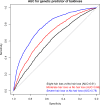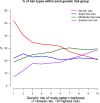Genetic prediction of male pattern baldness
- PMID: 28196072
- PMCID: PMC5308812
- DOI: 10.1371/journal.pgen.1006594
Genetic prediction of male pattern baldness
Abstract
Male pattern baldness can have substantial psychosocial effects, and it has been phenotypically linked to adverse health outcomes such as prostate cancer and cardiovascular disease. We explored the genetic architecture of the trait using data from over 52,000 male participants of UK Biobank, aged 40-69 years. We identified over 250 independent genetic loci associated with severe hair loss (P<5x10-8). By splitting the cohort into a discovery sample of 40,000 and target sample of 12,000, we developed a prediction algorithm based entirely on common genetic variants that discriminated (AUC = 0.78, sensitivity = 0.74, specificity = 0.69, PPV = 59%, NPV = 82%) those with no hair loss from those with severe hair loss. The results of this study might help identify those at greatest risk of hair loss, and also potential genetic targets for intervention.
Conflict of interest statement
I have read the journal's policy and the authors of this manuscript have the following competing interests: IJD and DJP are participants in UK Biobank.
Figures




References
-
- Hamilton JB. Patterned loos of hair in man: types and incidence. Annals of the New York Academy of Sciences. 1951;53(3):708–28. - PubMed
-
- Cash TF. The psychosocial consequences of androgenetic alopecia: a review of the research literature. British Journal of Dermatology. 1999;141(3):398–405. - PubMed
-
- Zhou CK, Levine PH, Cleary SD, Hoffman HJ, Graubard BI, Cook MB. Male Pattern Baldness in Relation to Prostate Cancer–Specific Mortality: A Prospective Analysis in the NHANES I Epidemiologic Follow-up Study. American Journal of Epidemiology. 2016;183(3):210–7. 10.1093/aje/kwv190 - DOI - PMC - PubMed
Publication types
MeSH terms
Grants and funding
- MC_UP_A620_1015/MRC_/Medical Research Council/United Kingdom
- MC_U147585827/MRC_/Medical Research Council/United Kingdom
- MC_QA137853/MRC_/Medical Research Council/United Kingdom
- MC_UU_12011/2/MRC_/Medical Research Council/United Kingdom
- BB_/Biotechnology and Biological Sciences Research Council/United Kingdom
- MC_U147585819/MRC_/Medical Research Council/United Kingdom
- MR/K026992/1/MRC_/Medical Research Council/United Kingdom
- MC_UP_A620_1014/MRC_/Medical Research Council/United Kingdom
- MC_UU_12011/1/MRC_/Medical Research Council/United Kingdom
- G0400491/MRC_/Medical Research Council/United Kingdom
- MC_U147585824/MRC_/Medical Research Council/United Kingdom
LinkOut - more resources
Full Text Sources
Other Literature Sources
Medical

